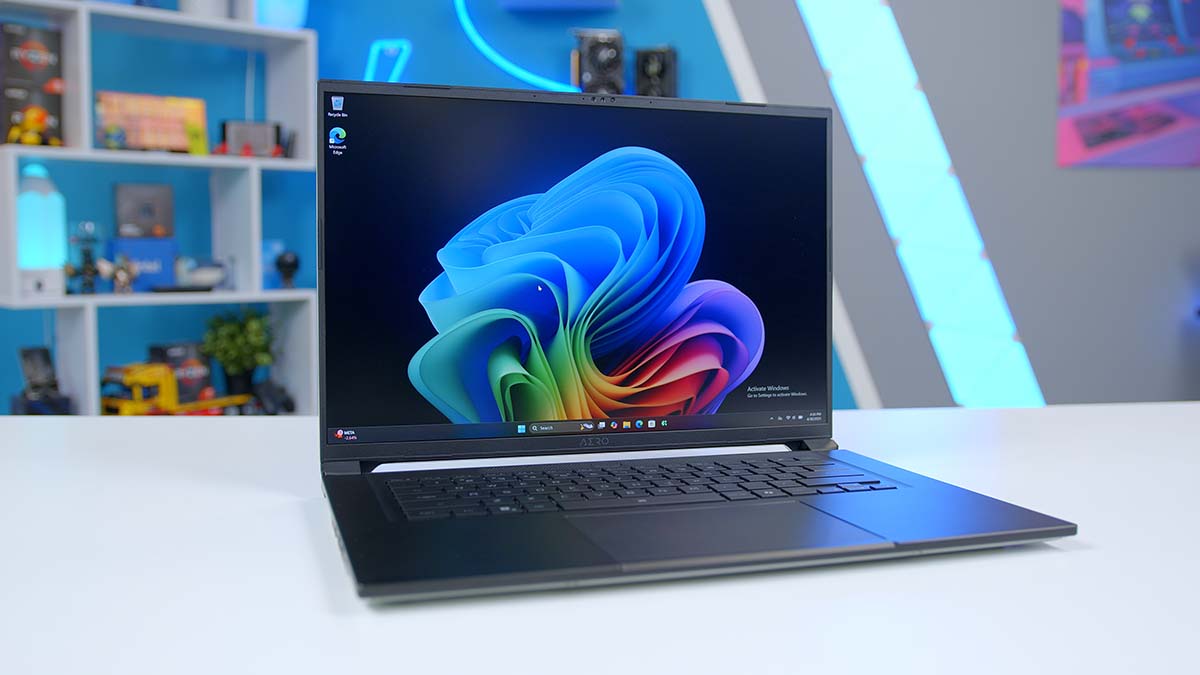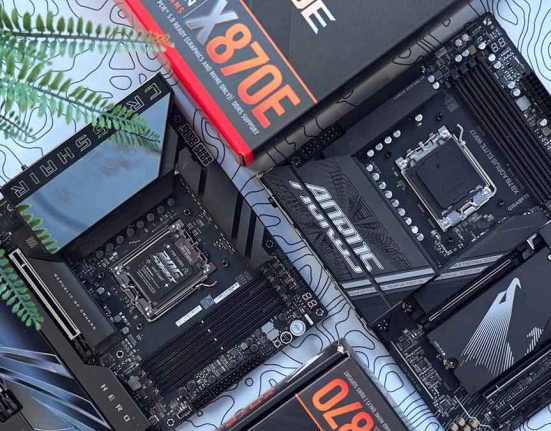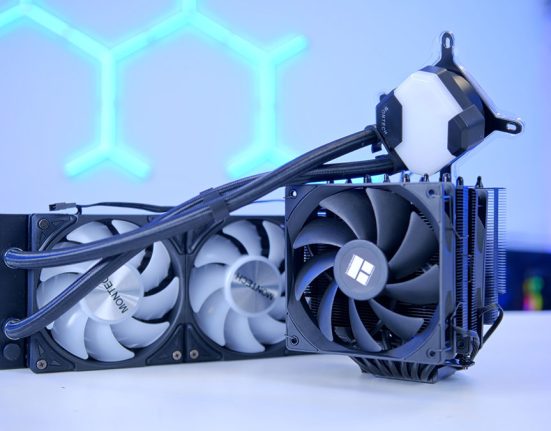The Gigabyte AERO X16 is a hybrid gaming and workstation AI laptop, designed to be used on the go in your favourite titles, while offering high-performance components for fairly intense workloads. Equipped with a Ryzen 9 laptop CPU, an RTX 5070 graphics card, and a crisp 16-inch 1440p display, the X16 is well-equipped to handle a range of cumbersome tasks.
However, the AERO X16 has joined a highly competitive market, where AI (artificial intelligence) is being used to heavily market new hardware. While AI has become an important topic in the PC hardware space, many manufacturers, including NVIDIA with their RTX 50-series launch, are leaning too heavily on AI features that don’t really offer much due to a lack of development and other factors. This raises concerns that the Gigabyte AERO X16 may have fallen into the same trap, which is further compounded by the fact that Copilot is regarded as one of the more rudimentary AI apps with various bugs and a considerable lack of functionality.
However, we’ll save all of the AI talk for later. We’ve put the AERO X16 Copilot+ laptop through the wringer, testing its gaming and workstation performance and various features to see if it is worth picking up compared to the competition. In this review, we’ve analysed the specs, design, features, and performance metrics to give you a solid overview of what this laptop offers.
Specification
At a glance at the specs, the AERO X16 has a decent set of specs on offer, catering to gamers and professionals. The brain of this laptop is the AMD Ryzen AI 7 350. The main difference between this CPU and a traditional Ryzen laptop CPU is that the Ryzen AI 7 350 is built to accelerate AI tasks. This processor features an NPU (neural processing unit), which takes some of the stress of AI workloads from other components. The Ryzen AI 7 350 has eight cores and sixteen threads that can reach a boost clock speed of 5GHz at the maximum.
The RTX 5070 laptop graphics card handles this system’s GPU horsepower. Laptop cards are notably slower than traditional desktop GPUs due to the type of silicon they use and temperature restrictions. However, with technologies like DLSS and Frame Gen, 1440p gaming should be a breeze for the AERO X16.

This laptop supports a maximum of 64GB, but the configuration that we were kindly sent by Gigabyte has 32GB of DDR5 RAM clocked to 5600MT/s. If you’re the kind of user who would benefit from more RAM, swapping out the SO-DIMMS is incredibly simple and will provide you with better performance. Storage-wise, the AERO X16 has a 1TB Gen4 NVMe M.2 SSD. However, there is an additional slot if the pre-configured storage isn’t enough for you, which is great to see.
Regarding the IO, the AERO X16 is a relatively lightweight and compact model, but it offers a decent selection of ports. There are four USB ports: two USB 3.2 Gen2 Type-A ports, a USB 2.0 port, and a USB4 Type-C port, which are ideal for those with fast external storage.
| Key Specs | Gigabyte AERO X16 Copilot+ |
|---|---|
| Processor | AMD Ryzen AI 7 350 |
| Graphics Card | NVIDIA GeForce RTX 5070 Laptop GPU |
| Memory | Up to 64GB DDR5 5600MT/s RAM |
| Storage | Up to 2 x 2TB PCI-E Gen4 M.2 SSD |
| USB Ports | 2 x USB 3.2 Gen2 Type-A 1 x USB 2.0 1 x USB4 Type-C |
| Additional IO | 1 x HDMI 2.1 1 x DisplayPort 1.4 (Type-C) 1 x RJ-45 1 x Audio Jack |
| Display | 16″ WQXGA (2560 x 1600) 165Hz |
| Networking | WiFi 6E Gigabit LAN |
| Operating System | Windows 11 Pro |
| Battery Life | 76Wh |
Alongside this selection of USB ports, there’s a dedicated HDMI 2.1 port, and DisplayPort 1.4 through the USB-C port, a Gigabit RJ-45 Ethernet connection, and a 3.5mm headphone jack. Overall, I’d say the IO selection is solid. There are plenty of USB ports and display outputs on offer, so there’s a significant amount of room to plug in multiple devices and extra displays.
The screen on the AERO X16 is a 1440p IPS display rated at 165Hz. While it’s a shame that the monitor isn’t OLED, I can understand that this likely wasn’t included to save on costs. However, the IPS monitor is vibrant, so the lack of an OLED panel isn’t a huge negative.
Last but not least, the AERO X16 comes with a pre-installed copy of Windows 11 Pro. This operating system offers slightly more bonuses than Windows 11 Home edition, such as additional security and cloud features, so this is a solid extra if you’re worried about security.
Gigabyte AERO X16 Design
The AERO X16 sits in a sustainable packaging box built entirely of cardboard. We’ve seen this with other modern products released in 2025, with manufacturers pushing to minimise landfills and decrease their carbon footprint, which is great to see. The packaging can be removed from the box to construct a sturdy laptop stand. This is an interesting design quality we’d like to see more of, as it makes the AERO X16 stand out more than the vast number of powerful machines in the existing market.

After taking the AERO X16 out of its sleeve, you’re greeted with a relatively compact, lightweight laptop with a brushed silver lid and an iridescent Gigabyte logo. This laptop also comes in black, but we have the lighter-coloured version on hand for this review. I’m a fan of the lighter colour, but it’s obviously more prone to visible bumps and nicks, especially if you take it on the go.

The lower portion of the chassis is made out of black plastic with another brushed silver bottom plate, adhering to the lighter colour across the board. The bottom plate has a range of slits and ventilation to allow air through, which pairs up nicely with the laptop stand, as the majority of the hot air is pushed out of the bottom. You’ll also find a series of vents around the sides and back to further assist airflow.

Once the laptop is open, you can spot the predominantly black chassis with an RGB keyboard and matte black touchpad. The RGB on the keyboard is reactive based on whether you’re using it. So inactivity powers off the lighting, which is a solid power-saving measure.

The aesthetic of the AERO X16 is fairly basic. While I prefer the lighter design in contrast to the fully black chassis, there’s nothing particularly special about the design. Gigabyte has chosen a minimalist approach, which many will appreciate, especially those who regularly take their laptop to an office or professional setup.
The RGB on the keyboard offers some typical gamer flair, which is nice to see, but I don’t think it adds much or takes away from the overall design. Some will prefer the mostly simplistic look, while others won’t.
Benchmarking & Gaming Performance
CPU-Z
To understand how this laptop performs, we decided to run synthetic and gaming benchmarks. The first application we ran was CPU-Z paired with HWMonitor to visualise temperature and clock speeds.
In this benchmark, we did a full thread run with all of the available cores. HWMonitor recorded an average temperature of 91°C while clock speeds hovered around 4.8GHz on the P cores and 3.4GHz on the E cores. The score on CPU-Z maxed out at 6686, which is fairly decent and puts it on par with a desktop Intel Core i7-12700. The Ryzen AI 7 350 offers a solid output when it comes to multi-threaded tasks, which is great to see.
Furmark 2.0
In Furmark 2.0, an application that tests graphics cards, we saw the RTX 5070 Laptop card average around 55°C, and this is at 100% usage. According to the data from Furmark, this card achieved an average framerate of 39FPS at 1440p. Ultimately, laptop cards will always be weaker than their desktop counterparts, which explains our results here.
Cyberpunk 2077
At 1440p with DLSS and Frame Generation enabled in Cyberpunk 2077, we saw an average framerate of 57FPS during this benchmark. I wasn’t blown away by the performance here, but I wouldn’t say I was disappointed either. I think 57FPS is more than playable, and by shifting around some of the settings, it’s highly likely you can reach much higher. Cyberpunk 2077 is a notably intensive game, so seeing a laptop card struggling is no surprise.
The bigger point of contention for most gamers here will be VRAM. Cyberpunk 2077 is pretty well optimised, so it doesn’t use massive amounts of video memory, but a game like Alan Wake 2 will likely use upwards of 12GB, which will likely cause issues for this card. Either way, it can definitely play Cyberpunk 2077, but you may have to play around with the settings.
Hogwarts Legacy
In Hogwarts Legacy at 1440p high with DLSS and Frame Gen on, performance was pretty much the same. You can enjoy the visual fidelity of this title, but at around 60FPS or so. This is playable, but there will be intense areas that will likely drop the framerate. So again, playing around with the settings will be key here.
Features We Like
Comes with a Windows Hello Camera
Windows Hello is a straightforward way to log into your device, similar to FaceID or a fingerprint scanner. However, it often requires a specific camera that is compatible with the Windows Hello API. Fortunately, the AERO X16 comes with a compatible camera, making it much easier to log in and more secure than a basic PIN or simple password.

Solid Battery Life
During my time with the AERO X16, I was pretty impressed with the battery life. Gigabyte boasts over 12 hours with a 76Wh capacity, which is solid if you don’t have an easily accessible plug while you’re on the go. I decided to play some games just with the battery as well and was expecting it to drain much quicker, but it held firm despite the intensity of the workload.

Features We Don’t Like
The AI Features Need Some Work
As discussed in the introduction of this article, AI is the big buzz in the tech space at the moment, but one caveat is that a lot of it is marketing. While it’s nice to see the integration of AI to provide some quality of life benefits, both GIMate and Copilot need some work. Copilot is widely regarded as one of the weaker AI assistants, and this is still apparent based on its lack of abilities and features.
GIMate could be helpful, but it needs some work. In its current state, GIMate is akin to something like the Razer Synapse application or Gigabyte’s very own Control Center. It allows you to modify settings with the click of a button, but its execution is limited. Additionally, Gigabyte’s claims that GIMate ‘responds instantly’ are a bit overzealous. Pressing the GIMate button opens up the application immediately (only if you’re on the Windows desktop and not tabbed into something like a game), which brings up a dialogue box that you can type into.
You can use the Windows microphone by hitting the Windows key + H, but you must stop the mic recording and hit Enter. Obviously, I’m being picky, but this demonstrates that GIMate needs some work and potentially a better integration into the Windows environment that requires fewer steps. I can see what Gigabyte is going for here, but I’m personally not a fan.
The Screen Isn’t Particularly Impressive
In our experience with Gigabyte laptops we’ve reviewed in the past, one thing’s for certain: Gigabyte laptop screens are excellent. However, for a laptop that’s supposed to provide a good balance of features for gaming and workstation activities, the screen is a bit disappointing. This is an IPS 1440p display, clocking in at 165Hz for the refresh rate.

This is perfectly fine for gaming, but if you plan on doing some video editing with high-fidelity footage, this display is going to be fairly limiting, especially when colour grading or working with 4K or even 8K media.
Conclusion
Gigabyte X16 W1h Copilot+ Laptop
Product Name: X16 W1H
Brand: Gigabyte
-
Features
-
Design
-
Performance
-
Value For Money
Summary
In a market where AI has become the buzz that everyone seems to be interested in, does the Gigabyte AERO X16 W1H Copilot+ do enough to stand out, or is it just another laptop that struggles to offer something unique? Unfortunately, the AERO X16 W1H generally falls in the latter classification. I wanted to love this laptop, but its underdeveloped AI features and somewhat underwhelming performance make it a fairly lacklustre option. A few good qualities are worth noting here, such as the battery life, Windows Hello integration, and metrics within modern games. But beyond this, the AERO X16 W1H is difficult to recommend.
It relies far too much on ‘AI features’ which feel gimmicky and don’t offer any major benefits besides taking up more processing power. I understand what Gigabyte were going for here, but the general execution feels poor. AI features need to provide a notable improvement across your day-to-day tasks. Otherwise, charging $300-500 more for what is essentially a desktop organiser feels a bit unfair. For now, we’ll stick to the older AERO models, like the OLED 16 BSF, which focuses more on performance.
Pros
✅ Solid battery life
✅ Windows Hello compatible
✅ Decent gaming performance
Cons
❌ Lacklustre AI features
❌ Unimpressive screen
❌ No SD card reader




![MPI_[DP055] SAMA V60 + 9070 Build Montage](https://geekawhat.com/wp-content/uploads/2025/12/FI_DP055-SAMA-V60-9070-551x431.jpg)



![FI_[DM78] Corsair Air 5400 + 5090 Gaming PC Build](https://geekawhat.com/wp-content/uploads/2025/11/FI_DM78-Corsair-Air-5400-5090-Gaming-PC-Build-551x431.jpg)